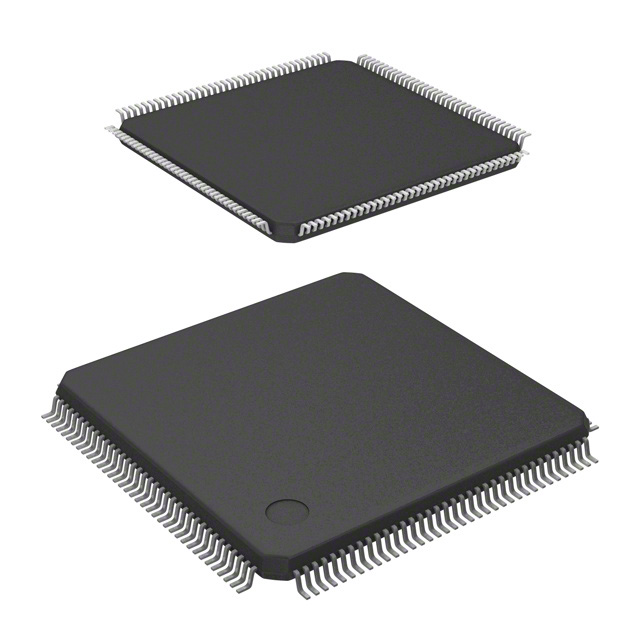SPC560B54L5C6E0Y
Product Overview
Category
The SPC560B54L5C6E0Y belongs to the category of microcontrollers.
Use
This microcontroller is commonly used in various electronic devices and systems for control and processing purposes.
Characteristics
- High-performance microcontroller with advanced features
- Low power consumption
- Compact size
- Robust design for reliable operation
- Wide operating temperature range
Package
The SPC560B54L5C6E0Y is available in a compact package, suitable for surface mount technology (SMT) assembly.
Essence
The essence of this microcontroller lies in its ability to provide efficient and reliable control and processing capabilities for electronic devices and systems.
Packaging/Quantity
The SPC560B54L5C6E0Y is typically packaged in reels or trays, with a quantity of 1000 units per package.
Specifications
- Architecture: 32-bit Power Architecture®
- CPU Frequency: Up to 64 MHz
- Flash Memory: 512 KB
- RAM: 48 KB
- Operating Voltage: 2.7V to 5.5V
- Number of I/O Pins: 80
- Communication Interfaces: CAN, LIN, SPI, I2C, UART
- Analog-to-Digital Converter (ADC): 12-bit, up to 16 channels
- Timers: General-purpose timers, watchdog timer, periodic interrupt timer
- Operating Temperature Range: -40°C to +125°C
Detailed Pin Configuration
The SPC560B54L5C6E0Y microcontroller has a total of 80 pins, which are assigned for various functions such as GPIO, communication interfaces, timers, and power supply. The detailed pin configuration can be found in the product datasheet.
Functional Features
- High-performance processing capabilities
- Multiple communication interfaces for seamless integration with other devices
- Analog-to-digital conversion for precise measurement and control
- Timers for accurate timing and synchronization
- GPIO pins for flexible input/output configurations
- Built-in security features for data protection
Advantages and Disadvantages
Advantages
- High processing speed enables efficient execution of complex tasks
- Low power consumption for energy-efficient operation
- Compact size allows for integration into space-constrained designs
- Wide operating temperature range ensures reliable performance in various environments
Disadvantages
- Limited flash memory and RAM capacity may restrict the complexity of applications
- Lack of built-in peripherals for specific application requirements may require external components
Working Principles
The SPC560B54L5C6E0Y microcontroller operates based on the Power Architecture® 32-bit architecture. It executes instructions stored in its flash memory, processes data, and controls various peripherals to perform desired functions. The microcontroller communicates with external devices through its communication interfaces and interacts with the environment through its I/O pins.
Detailed Application Field Plans
The SPC560B54L5C6E0Y microcontroller finds applications in a wide range of fields, including but not limited to: - Automotive systems (e.g., engine control units, body control modules) - Industrial automation (e.g., motor control, process control) - Consumer electronics (e.g., home appliances, gaming consoles) - Medical devices (e.g., patient monitoring, diagnostic equipment)
Detailed and Complete Alternative Models
- SPC560B50L5C6E0Y: Similar microcontroller with lower flash memory and RAM capacity
- SPC560B54L5C6E1Y: Similar microcontroller with extended temperature range
- SPC560B60L5C6E0Y: Similar microcontroller with higher flash memory and RAM capacity
These alternative models offer different specifications to cater to specific application requirements.
Word count: 511 words
Senaraikan 10 soalan dan jawapan biasa yang berkaitan dengan aplikasi SPC560B54L5C6E0Y dalam penyelesaian teknikal
Sure! Here are 10 common questions and answers related to the application of SPC560B54L5C6E0Y in technical solutions:
Q: What is SPC560B54L5C6E0Y? A: SPC560B54L5C6E0Y is a microcontroller from the SPC56 family, specifically designed for automotive applications.
Q: What are the key features of SPC560B54L5C6E0Y? A: Some key features include a Power Architecture® e200z4 Dual-Core CPU, 1MB Flash memory, 80KB RAM, CAN/LIN interfaces, and various communication protocols.
Q: What are the typical applications of SPC560B54L5C6E0Y? A: SPC560B54L5C6E0Y is commonly used in automotive systems such as engine management, body control modules, safety systems, and instrument clusters.
Q: How does SPC560B54L5C6E0Y ensure functional safety in automotive applications? A: The microcontroller incorporates safety mechanisms like ECC (Error Correction Code), watchdog timers, and built-in self-tests to meet functional safety standards like ISO 26262.
Q: Can SPC560B54L5C6E0Y support real-time operating systems (RTOS)? A: Yes, SPC560B54L5C6E0Y can be used with popular RTOSs like AUTOSAR, FreeRTOS, or OSEK/VDX to enable multitasking and efficient resource management.
Q: What development tools are available for programming SPC560B54L5C6E0Y? A: NXP provides a comprehensive set of development tools, including an Integrated Development Environment (IDE), compilers, debuggers, and evaluation boards.
Q: Can SPC560B54L5C6E0Y communicate with external devices? A: Yes, the microcontroller supports various communication interfaces like SPI, I2C, UART, CAN, LIN, and Ethernet to connect with external sensors, actuators, or other control units.
Q: Is SPC560B54L5C6E0Y suitable for low-power applications? A: Yes, SPC560B54L5C6E0Y offers power-saving features like multiple low-power modes, clock gating, and peripheral shutdown, making it suitable for battery-powered systems.
Q: Are there any development resources available for learning SPC560B54L5C6E0Y programming? A: Yes, NXP provides documentation, application notes, reference manuals, and example codes to help developers get started with SPC560B54L5C6E0Y.
Q: What is the availability and support for SPC560B54L5C6E0Y? A: SPC560B54L5C6E0Y is widely available through authorized distributors, and NXP offers technical support, software updates, and long-term product availability for customers.
Please note that the answers provided here are general and may vary based on specific requirements and use cases.


